![]()
![]()
![]()
Use LEFT and RIGHT arrow keys to navigate between flashcards;
Use UP and DOWN arrow keys to flip the card;
H to show hint;
A reads text to speech;
193 Cards in this Set
- Front
- Back
- 3rd side (hint)
|
What are the 2 main events of dna division? |
Mitosis - nuclear division Cytokinesis - cytoplasm division (creates 2 daughter cells) |
|
|
|
What are chromatids? |

2 dna copies that have been replicated and remain attached until the cell divides |
|
|
|
What is semiconservative replication? Who proposed it? |
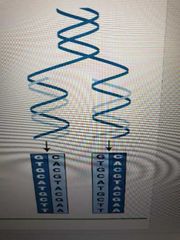
1 strand of dna is from a parent molecule. The second strand of dna is a newly synthesized strand.
From frances Crick. |
|
|
|
List and describe DNA replication models |

Semiconservative - 1 parent strand, 1 synthesized strand
Conservative - 2 parent strands, 2 synthesized strands
Dispersive - every double helix has mix of parent and synthesized segments
|
|
|
|
Who conducted the semiconservative replication experiment? |
Meselson and Stahl, with Jerome Vinograd |
|
|
|
Who discovered that dna direction is usually bidirectional? |
John Cairns |
|
|
|
Describe John Cairn's experiment |
3H-thymidine in bacteria allowed thymine to show up under autoradiography
Observed radiation forks that showed replication occurring in 2 diff directions starting from a spot called the origin of replication (see youtube "Bidirectional DNA replication" by Jose Velasquez) |
|
|
|
Another name for bacterial, bidirectional replication |
Theta replication |
|
|
|
What happens after circular dna copies itself? |
The 2 copies bind to the plasma membrane at their origins, and the cell divides by binary fission (cytoplasm cleaves and pinches off into 2 cells) |
|
|
|
How do eukaryotes undergo bidirectional replication |
Multiple origins of replication (replicons) form along the strand and create replication forks. This creates replication bubbles Eventually all replicons will meet to form a complete daughter dna strand (see youtube "177 Multiple Replicons in Eukaryote" by Gerry Bergtrom) |
|
|
|
How many replicons can a dna strand have? How long are they? |
Several thousand replicons 50k-300k BP in length |
|
|
|
What is e.coli's origin of replication made of? What is a consensus sequence? |
245 AT rich bp's in alternating sequences of three 13-mers and four 9-mers (13 bps and 9 bps) Sequence varies in other bacteria, but are similar (consensus sequence) |
|
|
|
What are initiator proteins? |
Proteins that recognize origin of replication sequences and bind to initiate dna synthesis |
|
|
|
List Differences between replication origins for ecoli and saccharomyces cerevisiae |
Ecoli - origin of replication (oriC) Sacch - autonomously replicating sequence (ARS) Ecoli - 245bp length Sacch - 100-150 bp length Ecoli - 13-mer and 9-merrepeating sequences Sacch - 11bp core sequence |
|
|
|
List steps of bacteria replication initiation |
1. DnaA enzyme binds to 9-mer, which causes unwinding of 13-mer section. 2. Single-stranded binding protein stabilizes unwound strands 3.DnaC loader brings DnaB helicase to unwound section 4. DnaB uses ATP to unwind dna strands at each replication fork |
|
|
|
List steps in eukaryote replication initiation |
1. Origin recognition complex (ORC) proteins bind at replication origin 2. Helicase loaders bring minichromosome maintenance proteins (with helicases)(MCM) to the origin 3. ORC + MCM + loaders = pre-replication complex |
|
|
|
When do replicons replicate? |
Genes that are actively expressed replicate early in S phase. Inactive genes are replicated later in S phase |
|
|
|
What is dna polymerase and how does it work? |
Enzyme that elongates dna chain (original is called dna polymerase 1) Requires template dna strand. Matches BP using high-energy deoxynucleoside triphosphates. Releases 2 of the phosphate groups to form a phosphodiester bond along the 3' OH group (chain forms from 5' to 3') |
|
|
|
Explain okazaki's experiment |
He isolated bacteria that was exposed to radioactivity and found the radioactivity was located in small fragments that eventually became associated with longer molecules *unless* there was no dna ligase. |
|
|
|
What is replication proofreading? |
Ability of DNA polymerase to recognize and correct a mistake during replication using exonuclease or endonuclease |
|
|
|
Difference between exonuclease and endonuclease? |
Exo removes nucleotides at the end of a strand (the 3' end)
Endo removes nucleotides from the middle of a dna strand |
|
|
|
Why are exonucleases 3' to 5' |

They have to work backwards to correct mistakes by dna polymerase as it moves 5' to 3' |
|
|
|
List reasons researchers knew rna was involved in replication initiation |
1. Okazaki fragments have rna at 5' ends 2. DNA polymerase can elongate rna chains 3. Cells have primase to make rna primer chains from dna templates 4. Primase can initiate rna strands without pre-existing chain to add to |
|
|
|
Difference between rna polymerase (primase) and dna polymerase? |
DNA polymerase requires a primer to start a strand. RNA primase can initiate a primer from nowhere |
|
|
|
What is a primosome? |
Found in ecoli but not eukaryotes - primase must be activated by 6 other proteins, including helicases to form a complex called primosome |
|
|
|
How is dna replicated using an rna primer? |
1. Primase adds rna primer to single dna strand. 2. dna polymerase 3 (bacteria) or dna polymerase alpha + epsilon or delta (eukaryotes) adds dna nucleotides to rna primer strand 3. DNA polymerase 1 replaces rna with dna 4. DNA ligase seals gap See youtube "Enzymes in DNA replication" by Sarah Flinker |
|
|
|
How do single stranded binding proteins work? |
They attach to unwound dna and block them from reforming into a double strand. Once replication has occurred, they fall off and move to another single strand segment |
|
|
|
What does topoisomerase do? Most important one in e.coli? |
Alleviate tension from supercoiling by breaking and resealing twisted dna strands (makes swivel points) Gyrase is key for e.coli replication |
|
|
|
What is a replisome? |
Protein complex found at replication fork required for dna synthesis |
|
|
|
List parts of replisome |
Helicase (break double strand) Gyrase (topoisomerase untwist strands) Single-strand binding protein (stabilizes split strands) DNA polymerase (elongates DNA chain) Ligase (seals gaps) |
|
|
|
What powers replisome activity? |
Nucleotide triphosphate hydrolysis |
|
|
|
Explain the trombone model |
A sliding clamp loader attaches a sliding clamp and the polymerase onto a dna strand. The clamp keeps the polymerase in position as it moves down the 3' end.
Will stay for the entire length of replication on leading strands. On lagging strands, polymerase falls off and clamp must be reloaded. See youtube "DNA Replication Animation - initiation, elongation, and termination" by Biology animation videos |
|
|
|
What is the clamp protein for eukaryotes? |
Proliferating nuclear cell antigen (PNCA) for dna polymerase delta |
|
|
|
How do replication factories work? |
Chromatin is fed through stationary factory where:
1.Chromatin remodeling proteins loosen nucleosome packing 2. DNA is replicated 3. Nucleosome assembly protein-1 and Chromatin assembly factor-1 reassemble nucleosomes
|
|
|
|
What is the telomere sequence for human chromosomes? |
TTAGGG |
|
|
|
What happens without telomeres? |
Each round of replication shortens the dna molecule because 5' primers are removed by exonuclease and cannot have BP's added |
|
|
|
What are telomeres |
Noncoding repeating sequences that protects genetic info against loss during replication |
|
|
|
What is telomerase? |
Enzyme with both rna and protein that facilitates synthesis of telomere repeating sequences. RNA is the template for the DNA telomere sequence |
|
|
|
How do telomeres protect themselves? |
Telomere capping proteins bind to the exposed 3' end In eukaryotes, the 3' end can loop around and base pair with the opposite dna strand |
|
|
|
Where is telomerase found in multicellular organisms? |
Germ cells that give rise to sperm and egg, and a few actively proliferating cells |
|
|
|
Explain the end of a cell's life span, regarding replication |
Telomeres are shortened after each division so cells have a finite number of times they can divide before they run out of telomeres.
Before a cell reaches that point and erodes it's own dna, it undergoes apoptosis |
|
|
|
List causes of dna mutations |
1. Spontaneous mispairing of BP's due to formation of tautomers 2. Slippage during replication 3. Spontaneous damage to bases |
|
|
|
What is the most common form of replication error? What happens? |
Tautomers - base pairs with alternate resonance structures that causes daughter strands with incorrect base. The tautomer pairs in a nonstandard way (tautomeric shift) |
|
|
|
How does slippage occur in replication? |

Trinucleotide repeats can slip, and polymerase copies a section of dna twice. The slipped section of dna forms a hairpin loop |
|
|
|
How do chemical modification mutation occur in replication (not from mutagens)? |
Depurination (removes A or G and replace with random base)
Deamination (removes amine group, most common: C becomes U and causes bp mismatch)
See youtube "Deamination Irradiation" by Larry Huang |
|
|
|
How many depurinations and deaminations does a human cell undergo? |
Depurination - 1000s per day Deamination - 100s per day |
|
|
|
List categories of environmental mutagens |
Chemical Radiation |
|
|
|
List chemical mutagens |
Base analogues ("fake" nitrogenous bases) Base-modifying agents (changes base structures) Intercalating agents (insert themselves between bases) |
|
|
|
What is a base analogue? Give an example |
Molecules that are structurally similar to a nucleotide and can cause incorrect base pairing Ex: BrdU pairs similarly to thymine |
|
|
|
List examples of base-modifying agents |
EMS - adds ethyl groups Nitrous acid - increased deamination DNA adduct additions - ex: aflatoxin b1 attaches to guanine and causes depurination |
|
|
|
What do intercalating agents do? |
Insert themselves into the double helix and cause nicks in the dna. Repairing intercalating agents may result in nucleotide addition or deletion |
|
|
|
List examples of intercalating agents |
Proflavin Acridine orange Benzopyrene Ethidium bromide - fluorescent dye for gel electrophoresis |
|
|
|
List and describe the types of radiation mutations |
Ultraviolet- causes pyrimidine dimer formation (covalent bonds between pyrimidines) X-ray - ionizing radiation removes electrons to cause reactive, destructive intermediates |
|
|
|
What is photoactive repair? |
Photolyase uses energy from visible light to catalyze breakage of bonds between thymine dimers (remember pyrimidine dimers from radiation) |
|
|
|
List excision repair pathways |
Base excision repair Nucleotide excision repair |
|
|
|
How does base excision repair work? |
DNA glycolase removes deaminated base AP endonuclease breaks phosphodiester backbone to release depurinated base. A second enzyme removes the base DNA polymerase inserts a new base Ligase seals the nick. |
|
|
|
How does nucleotide excision repair work? |
Proteins (UVR-AB complex) detect defects in dna strand
NER endonuclease (excinuclease) cuts a section of dna out from either side of defect.
Helicase unwinds cut section and releases it
Polymerase and ligase replace and seal missing bases See youtube "Nucleotide excision repair" by Andrew vinal |
|
|
|
How are repairs identified after replication? |
A mismatch repair system identifies original, correct dna from defective new dna strand because the original dna strand will be methylated |
|
|
|
List steps for mismatch repair |
MutS protein detects mismatch
MutH endonuclease creates a nick
Exonuclease (dna polymerase) removes defective nucleotide
New bp is inserted and sealed |
|
|
|
Describe non-homologous end joining |
1. Both strands are broken from damage 2. KU80-KU70 protein complex binds to broken dna ends 3. Nuclease trim off broken ends 4. DNA ligase seals the trimmed ends
Cannot be used on template dna sequences due to loss of rna, aminos, and proteins. Very disruptive. |
|
|
|
Describe synthesis-dependent strand annealing |
1. Double-stranded break is recognized and trimmed 2. Rad51 protein binds so that strands can search for homologous sequence on sister chromatid (strand invasion) 3. Invading strand replaces sequence on sister chromatid to create a d loop 4. Single strand from broken dna is replicated 5. Repaired dna dissociated from d loop and ligated |
|
|
|
Describe homologous recombination |
1. Break is detected and ends trimmed 2. Stand invasion for both dna strands occur 3. Holliday junction forms to create 2 separate strands of repaired dna
|
|
|
|
What is central dogma and who coined it? |
Directional info flow from dna to rna to protein, by frances crick. Sometimes stops at rna |
|
|
|
What is transcription and translation? |
Transcription - makes rna from dna Translation - makes protein from rna |
|
|
|
List exceptions to central dogma |
Retroviruses (HIV, several animal cancers) do reverse transcription - rna is the template for dna
Other viruses make rna from an rna template |
|
|
|
List types of rna and their functions |
Mrna - translates into protein Rrna- component of ribosome Trna- brings amino acids to ribosomes |
|
|
|
Where does transcription and translation happen in bacteria and eukaryotes? |
Bacteria has no nucleus so translation can start while transcription is occurring. Eukaryotes - transcription in nucleus, translation in cytoplasm |
|
|
|
What is the enzyme used for reverse transcription? |
Reverse transcriptase |
|
|
|
Explain how a provirus is formed |
2 copies of the rna genome plus copies of reverse transcriptase are enclosed in the virus
1. Virus binds to host cell and fuses its envelope with plasma membrane
2. Reverse transcriptase catalyzes synthesis of dna strand complementary to its rna
3. Reverse transcriptase makes second dna complementary to the first
4. Double stranded dna enters the host nucleus and is transcribed by the host cell. 5. This rna is mrna to direct synthesis of viral proteins, or packed with viral proteins into new virus particles that bud from the plasma membrane |
|
|
|
Describe Beadle and Tatum experiment. |
X-rayed bread mold neurospora to create mutations that would not synthesize amino acids or vitamins in minimal medium but grew in complete medium. Grew mutants in several mediums each with a single amino acid or vitamin and discovered several different mutants. Supplemented minimal medium with metabolic precursors of a certain amino or vitamin and saw each mutation disabled a single enzyme step Made one gene-one enzyme hypothesis that each gene coded for a single enzyme |
|
|
|
Describe Ingram's experiment |
Pauling ran sickle cell hemoglobin through electrophoresis (separate by size and charge) and saw sickle cells migrated differently
Ingram used trypsin protease to cleave hemoglobin into peptide fragments and saw only one peptide differed between regular and sickle hemoglobin (instead of negative charged glutamic acid, sickle has neutral valine)
Changed one gene-one enzyme theory to one gene-one polypeptide to incorporate all proteins, not just enzymes |
|
|
|
What is the genetic code? |
Order of nucleotides in mrna, used to decipher amino acid sequence.
Makes up a set of rules that determine the order of amino acids from the DNA base sequence |
|
|
|
What is the triplet code? |
To account for all 20 amino acids, combos of 3 nucleotides form each amino acid (there are a total of 64 combinations) |
|
|
|
What is a frame shift mutation? |
Nucleotide insertion or deletion (indel) that disrupts how the dna sequence is read by shifting the reading frame |
|
|
|
What is a degenerate code? |
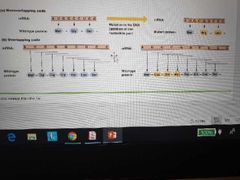
An amino acid can be identified by multiple triplet codes. It does NOT overlap |
|
|
|
How is mrna transcription different from dna replication? |
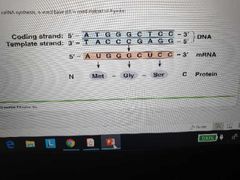
1. DNA makes copies of both template and coding strands. Mrna only copies DNA's template strand (the 3' to 5' one) 2. mrna uses U instead of T |
|
|
|
61 codons code for what? What are the remaining 3 codons |
62 codons code amino acids plus the start codon (AUG) The other 3 are stop codons (UGA, UAG, UAA) |
|
|
|
What is the difference between unambiguous versus denegerante coding |
Unambiguous - each triplet code only stands for a single amino acid Degenerate- each amino acid can have multiple triplet codes |
|
|
|
List exceptions to the genetic code's universality |
64 codons almost always stand for the same amino acid or stop signal regardless of organism Exceptions are in mitochondria (has it's own dna and does it's own transcription and translation) and some bacteria. -AGA is arginine, but a stop codon in mitochondria. -Some codons specify nonstandard amino acids |
|
|
|
What is a transcription unit? |
DNA that gives rise to one RNA molecule |
|
|
|
List and summarize 4 stages of transcription |
Binding - rna polymerase binds to promoter sequence and double helix unwinds Initiation - rna polymerase initiates rna synthesis from dna template strand Elongation- rna polymerase moves along template to unwind dna and elongate the RNA Termination - rna polymerase leaves template and rna molecule is released |
|
|
|
What is a transcription bubble |
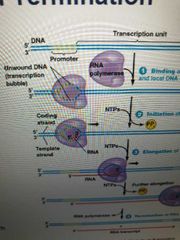
Unwound dna |
|
|
|
What is a promoter site? |
Several dozen bp sequences that signal where rna synthesis needs to start |
|
|
|
What is upstream and downstream |
Where something is located on a transcription unit. Upstream is closer to 5'. Downstream is closer to 3' |
|
|
|
What is the promoter consensus sequence for bacteria transcription? |
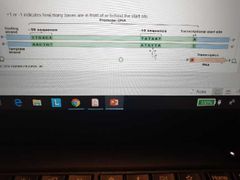
+1 start site is a purine (usually A) -10 nucleotides to left of start site is Pribnow Box/ -10 sequence TATAAT -35 nucleotides left of start site is -35 sequence TTGACA strong promoters may also have upstream elements |
|
|
|
What is rna polymerase composed of? |
2 alpha subunits 2 beta subunits 1 sigma subunit that binds to promotor sequence and eventually falls off C-terminal domain allows polymerase to move forward via phophorylation |
|
|
|
What is the core enzyme vs holoenzyme in transcription? |
Holoenzyme contains sigma subunit crucial for initiation Core enzyme does not have sigma subunit and can only carry out rna synthesis after initiation |
|
|
|
Describe transcription initiation for bacteria |
Rna Polymerase attaches to promotor and unwinds dna.
Ribonucleoside triphosphates are base paired by phosphodiester bonds, 9 nucleotides or less at a time and then released. This happens repeatedly (abortive initiation)
Rna Polymerase remains stationary but pulls DNA into it, causing scrunching.
Once rna strand 10 nucleotides or longer is made, it escapes, releasing the sigma factor. The polymerase can now move along the DNA |
|
|
|
Describe elongation during transcription |
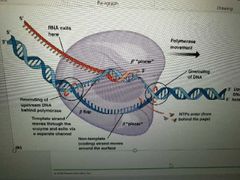
Polymerase moves along dna molecule, which is unwound ahead of the polymerase and rewound once it leaves. RNA is elongated 5' to 3' eith nucleotides added at 3' end
|
|
|
|
What is rna backtracking? |
Polymerase backs up and removes incorrect nucleotide when errors form |
|
|
|
Why arent rna errors as important as dna errors? |
DNA is used as a template to make more dna, while rna does not make any more duplicates of itself. Therefore a mistake in rna will not be repeated |
|
|
|
Describe transcription termination when rho factor isnt needed |
The termination rna sequence has a GC rich region followed by several U's.
The GCs base pair and form a hairpin loop. However the U's of rna and the As of dna have a weak bond break. RNA is released. |
|
|
|
Describe transcription termination when rho factor is present |
The rho termination sequence is 50-90bp near 3' end of rna. Rho enzyme binds to this and then uses ATP to move along rna til it reaches polymerase, unwinding rna from dna See youtube "rho-dependent transcription termination in prokaryotes" by Honeywolf |
|
|
|
How is eukaryotic transcription different from bacterial? |
Eukaryotes have: -3 rna polymerases -Promoters are more varied and some are downstream -Require transcription factors before polymerase binds -Protein-protein interaction -RNA cleavage determines 3' end -RNA undergoes rna processing modification during and after transcription |
|
|
|
What are eukaryotes 3 rna polymerases? Are the sensitive to alpha amanitin inhibitor? Where are they located? |
RNA polymerase 1 - no - nucleolus RNA polymerase 2 - very - nucleoplasm RNA polymerase 3 - somewhat - nucleoplasm |
|
|
|
What are the parts of the rna polymerase 1 promoter? |
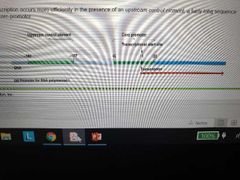
Core promoter - smallest set of dna sequence to start transcription
Upstream control element - longer sequence that increases transcription efficiency
|
|
|
|
List the sequence elements of rna polymerase 2's core promoter. What are the types of core promoters? |
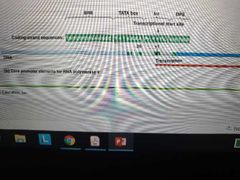
1. Initiator sequence 2. TATA box at -25 3. TFIIB recognition element (BRE) 4. Downstream promoter element (DPE) at +30
Types: -TATA driven - initiator, TATA with or without BRE -DPE driven - initiator, DPE only
|
|
|
|
List common upstream control elements in transcription. |
CAAT box GC box |
|
|
|
What are proximal control elements and enhancer elements? |
Upstream control elements: Proximal - within 100-200 nucleotides of start point Enhancer - farther than 200 nucleotides of start point |
|
|
|
Describe rna polymerase 3 promoters |
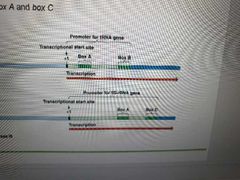
10 bp sequences all downstream of start point Rrna - Box A and C Trna - Box A and B |
|
|
|
What is the preinitiation complex vs prereplication complex? |
In eukaryotic transcription, preinitiation is composed of polymerase and transcription factors In eukaryotes, prereplication is the orc and mcm |
|
|
|
What is TF2H and TF2D? |
Tf2h - has unwinding helicase and kinase that phosphorylates C-terminal domain (tail that allows rna elongation l)
Tf2d - binds to dna promoter due to its TATA binding protein |
|
|
|
List TF binding order |
D A and B F E and H "Dabfeh* |
|
|
|
What signals termination for each eukaryotic rna polymerase? |
RNA polymerase 1 - protein recognizes 18-nucleotide signal Rna polymerase 2 - cleavage site 10-35 nucleotides downstream of AAUAAA sequence, which contains the polyA tail Rna polymerase 3 - repeated U's. No protein factor needed |
|
|
|
What is the structure and function of the nucleolus? |
Function - ribosome synthesis
Contains: Fibrils - has dna which is transcribed to rna
Granules - rrna molecules being packed with proteins to make subunits
Proteins from cytoplasm - enters through nuclear pore to make subunits |
|
|
|
Differences and similarities between regular introns and the second class of introns? |
Second class introns have AU and AC instead of GU and AG splice sites Uses different spliceosomes from SNRNP snRNA still involved with recognition' splicing' and spliceosome assembly |
|
|
|
What are ribozymes? |
Catalytic rna molecules
Ex: Self-splicing introns that dont require proteins |
|
|
|
What happens to introns after they are spliced? |
Most are destroyed Some are translated into proteins Some are processed to make functional products |
|
|
|
How does alternative splicing occur? |
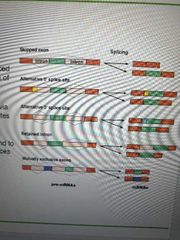
snoRNA bind to splicing enhancer or silencer sequences that trigger splice sites to either be activated or skipped |
|
|
|
How is trna processed during transcription? |
Trna folds into a cloverleaf structure with 4 hairpin loops and possibly a 5th variable loop.
Synthesized as pre-trna
16-nucleotide Leader sequence is removed at 5' end, terminal nucleotides replaced with cca at 3' end
10-15% nucleotides are chemically modified (methylation, creation of unusual bases)
14-nucleotide intron is removed from a few trnas
|
|
|
|
How is rrna processed in transcription? |
The 3 rnas that make up the larger subunit (5.8s, 18s, 20s) are transcribed together as one unit to create equal amounts of each. This creates pre-RNA.
Each rrna is separated by transcribed spacers, which are then cleaved and rrnas methylated by snoRNAs (small nuclear rna)
|
|
|
|
What is a 5' cap? What is its function? |
Guanosine that is methylated at position 7 and bound by 5'-5' link.
Added after transcription initiation to protect mrna from nuclease and position mrna onto ribosome for translation initiation |
|
|
|
Which genes have RNA as final product? |
Trna Rrna |
|
|
|
Where are ribosomes found |
Rough er Cytoplasm Nuclear envelope Chloroplasts and mitochondria |
|
|
|
Most common rna form? What are its subunit sizes? |
Rrna - 70-80% of all rna
Bacterial - 50s, 30s subunits = 70s Eukaryotes- 60s, 40s subunits = 80s |
|
|
|
List 4 sites of a ribosome |
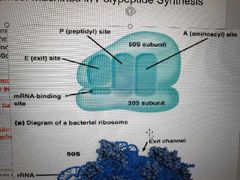
Mrna binding site (A)minoacyl site - where trna with amino acid attaches (P)eptidyl site - contains growing peptide chain (E)xit site - where uncharged trna leaves |
|
|
|
How is trna linked to an amino acid? |
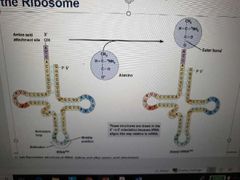
Ester bond |
|
|
|
How is trna named? |
Named according to amino acid attached to it. Ex: tRNAala for alanine |
|
|
|
What is an aminoacyl trna? |
Trna that is attached to amino acid *trna is "charged". Amino is "activated" |
|
|
|
How does trna recognize mrna codons? |
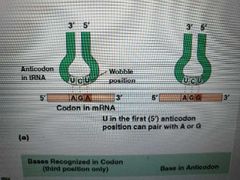
Trna has an anticodon triplet that is antiparallel and complementary to 1+ mrna codon for its specific amino acid. See hint funct for extra photo |
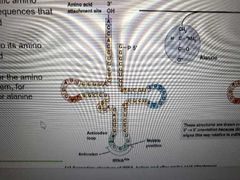
|
|
|
What is the wobble hypothesis? |
Allows for unexpected bp through flexibility of Trna's 3rd codon base and mrna's first codon base. This allows trna to recognize more than one codon as long as they code for the same amino acid Allows for fewer trna molecules (no need to have 64 trnas for 64 triplet combinations) |
|
|
|
What are aminoacyl synthetases and how many are there? |
Enzymes that link amino acids to correct trna through atp hydrolysis
20, one for each amino, plus one for each nontraditional amino acids |
|
|
|
List steps of aminoacyl trna synthesis |
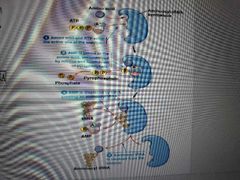
1. Amino acid and atp enter aminoacyl synthetase 2. ATP sheds 2 phosphates to become AMP and binds to amino 3. AMP is replaced by trna 4. Aminoacyl trna is released
|
|
|
|
How does aminoacyl synthetase know which trna to bind to each amino acid? |

It recognizes and reads the anticodon sequence of trna as well as its 3' end.
Then it proofreads the final product before releasing the aminoacyl trna
*synthetase ->recognizes amino + trna -> trna recognizes mrna codon |
|
|
|
What is monocistronic vs polycistronic? |
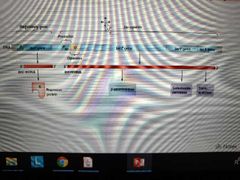
Monocistronic mrna encodes for only one gene/polypeptide
Polycistronic mrna codes for several related polypeptides (found in bacteria and archaea). Ex: lac operon is one mrna transcript that codes for 3 genes |
|
|
|
Another name for polycistronic mrna strand? |
Operon |
|
|
|
Describe translation initiation in eukaryotes |
1. eIF2 + gtp binds to tRNAmet 2. This complex binds to small ribosome subunit 3. Other eIFs bind 4. This forms 43s preinitiation complex, which uses eIF4F to recognize and bind to 5' cap of mrna OR (in viral mrna) an internal ribosome entry sequence in front of AUG 5.43s preinitiation complex scans mrna for AUG and its Kozak sequence surrounding AUG (ACCAUGG) 6. GTP hydrolysis attaches large ribosome subunit
See youtube "Eukaryotic Translation Initiation" by MedLecturesMadeEasy |
|
|
|
How is mrna polyadenylated? Why is it important? |
PolyA-binding protein adds polyA tail to protect mrna and help it travel out of the nucleus. It also attaches eIF4G, which is important for translation initiation |
|
|
|
Summarize steps of elongation in translation |
1. Aminoacyl trna binds to ribosome and positions a new amino acid in place 2. Amino is linked to chain by peptide bond formation 3. Translocation advances mrna through ribosome 3 nucleotides at a time |
|
|
|
How does aminoacyl trna (not the initiation trna) initially bind to the ribosome in translation? |
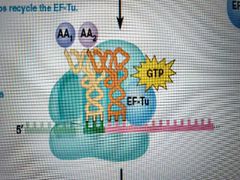
Mrna start codon is at the P site. The next codon that will match the aminoacyl trna is at the A site.
Elongation factors EF-Tu and EF-Ts bring random aminoacyls (except initiator tRNAs) to the A site. If the amino acyl is complementary to the mrna codon, GTP hydrolysis links it to the chain.
As a result, initiator tRNA is at the P site. The next aminoacyl tRNA is at the A site.
|
|
|
|
How are amino acids connected during translation? |
The amino acid at the P site is transferred to the amino acid at the A site by a peptide bond between A site's amino and P site's hydroxyl (remember 5' to 3' directionality).
Enzyme that catalyzes this bond is NOT peptidyl transferase. It is rRNA (23S RNA in bacteria)
Trna with the peptide chain translocates from A site to P site. Newly emptied trna translocates from P site to E site. Completed by hydrolysis of GTP bound to EF-G causing a conformational change
See youtube "Chapter 4 Translation Elongation and termination" by StudentHelp4AP |
|
|
|
What are polyribosomes/polysomes? |
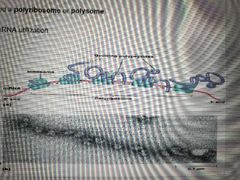
A "conveyer belt" of several ribosomes all translating the same mrna sequence at once to make tons of protein quickly. |
|
|
|
How is translation terminated? |
A stop codon (UAA, UAG, UGA) reaches the A site and is read by protein release factors (not trna). The polypeptide is released and the ribosome disassembles |
|
|
|
Purpose of chaperones? |
They bind polypeptides during early folding stages to prevent them from binding to other polypeptides before they have the correct conformation. Usually several chaperones in a row are required |
|
|
|
What happens to incorrectly folded proteins? |
3 options: -Corrected by chaperones -destroyed -incorrectly folded proteins bind to each other as insoluble aggregates inside and between cells |
|
|
|
How does hsp60 bacteria complex work? |
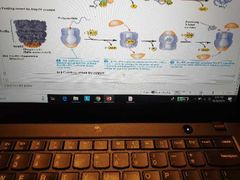
Misfolded or partial folded protein enters main chamber, called GroEL.
GroES "cap" subunit attaches and along with ATP hydrolysis, causes GroEL to change shape
Protein favorably folds in this new hydrophilic environment
Protein leaves, and a new GroES attaches at the opposite end See youtube "Mechanism of Chaperone Assisted Folding I Gro EL-ES System" by Hussain Biology
|
|
|
|
How does hsp70 work? |

As polypeptide chain is being formed, hsp70 loosely binds to polypeptide with hsp40, atp tightens the bind, and then hsp attaches to new atp and releases the polypeptide in its newly folded form
|
|
|
|
Why does protein synthesis use a lot of energy? |
Elongation requires hydrolysis of 4 high energy phosphoanhydride groups Each bond has a free energy input of 7.3 kcal/molecules for a total of 29.2kcal/mol Extra GTPs used to make initiation complex, during termination, and to bind incorrect aminoacyls |
|
|
|
What are base pair substitutions? List 3 types |
BP substitutions alter a codon. Missense mutation Nonstop mutation Nonsense mutation |
|
|
|
What is a missense mutation? Give an example |
Changing a single bp causes coding of the wrong amino acid in a protein Sickle cell - AT subbed for TA in DNA -> GUA codon instead of GAA mrna -> valine instead of glutamic acid |
|
|
|
What is a nonstop mutation? |
BP substitution that alters a stop codon and prevents termination of translation |
|
|
|
What is a nonsense mutation? |
BP substitution changes an amino acid codon to a stop codon and terminates translation too early |
|
|
|
What happens to mrna with no stop codon? |
Eukaryote - RNA-degrading enzyme binds to empty A site and degrades defective mrna (nonstop decay) Bacteria - transfer messenger rna (tmRNA) binds A site and directs addition of amino acids that signal the protein for destruction |
|
|
|
List types of posttranslational processing |
- Met or fMet is removed - entire sections of aminos removed (some enzymes arent activated until removal of these sections from the ends of their proteins) - transporting proteins may require removing internal aminos or removing a signal sequence - chemical modification (methylation, phosphorylation, acetylation, etc) - protein splicing (inteins removed, exteins remain) |
|
|
|
How is insulin posttranslated? |
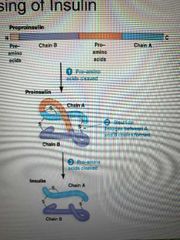
Initial polypeptide chain is called preproinsulin with a "pre" section of amino acids, a "pro" section of amino acids, and A and B subunit sections of amino acids
N-terminal pre aminos removed to make proinsulin
Chain is folded to distinguish A and B subunits by disulfide bonds
Pro amino acids are removed, leaving only A and B subunits
|
|
|
|
What is the result of a bp insertion or deletion? |
Frameshift mutation |
|
|
|
List mutations that affect only one bp |
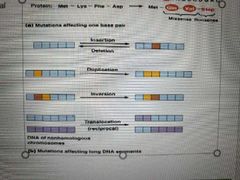
Indel Duplication Inversion Translocation (piece of one chromosome attaches to another) |
|
|
|
What is the benefit of selective gene expression? |
Allows cells to synthesize only what they need - increases efficiency |
|
|
|
Difference between constitutive vs regulated genes? |
Constitutive - expressed all the time (ex: ribosomal genes, glycolysis) Regulated - amt of product is specified to cell's particular need (ex: enzymes for metabolic processes) |
|
|
|
What is adaptive enzyme synthesis? |
Stopping and starting transcription depending on cell needs |
|
|
|
List metabolic pathways with examples |
Catabolic (degradative) - digestion, glycolysis Anabolic (synthetic) - protein synthesis |
|
|
|
What does it mean when enzymes are regulated coordinately? |
Synthesis of all enzymes in a catabolic or anabolic pathway is turned on and off together |
|
|
|
What are inducible enzymes? Give example |
Enzyme synthesis is turned on only in the presence of certain substrates (substrate induction). Usually for catabolic pathways
Ex: galactosidase permease transports lactose into cell. Once lactose is present, B-galactosidase synthesis is then induced to degrade lactose. |
|
|
|
What is an operon? |
A promoter that controls 2 or more Gene's. All genes are transcribed or none are transcribed |
|
|
|
What is end-product repression? Give example |
Amt of enzyme produced is inverse to concentration of end product. Usually in anabolic pathways Ex: as amt of tryptophan rises, enzymes for tryptophan synthesis are repressed |
|
|
|
What is feedback inhibition? |
Enzyme molecules are present, but their activity is inhibited |
|
|
|
What is repression? What does it affect? |
Reduced expression of a regulated gene Affects protein synthesis as well as activity |
|
|
|
What triggers induction and repression? |
Small organic molecules, usually substrates (catabolic) or end products (anabolic) |
|
|
|
What is lacI? |
Gene that induces the lac operon to synthesize lacYAZ in the presence of lactose. Without lacI, YAZ will be synthesized constitutively |
|
|
|
What make up the lac operon? |
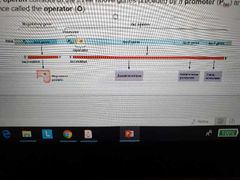
lacZYA, a Plac promoter, and an Operator sequence |
|
|
|
What is a repressor protein? Describe lac repressor |
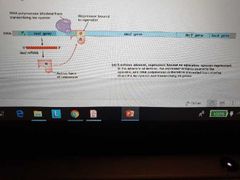
Regulatory gene product that inhibits expression of other genes LacI DNA gene codes for lac repressor protein, which binds to the Operator. Then rna polymerase cant transcribe lacZYA |
|
|
|
Describe central dogma starting with lac operon |
LacI gene plus lac operon dna transcribes lac-mRNA, which translates to lactose enzymes (B-galactosidase, galactose permease, transacetylase) |
|
|
|
List steps of lactose enzyme synthesis |
1. LacI DNA codes for repressor protein 2. Repressor protein binds to operator (synthesis is turned off) 3. Allolactose inducer molecule binds to the repressor (synthesis is turned on) 4. RNA polymerase transcribes the operon to form B-galactosidase, galactose permease, transacetylass |
|
|
|
What is an allosteric protein? Give example |
Protein with more than 1 binding site Ex: lactose repressor protein binds to Plac DNA promotor and blocks transcription. Also binds to allolactose to change conformation and allow transcription of lac operon. |
|
|
|
How is the induction of the lac operon triggered? |
Allolactose binds to repressor protein so that it changes shape and cant bind to the operator |
|
|
|
What is an inducible operon? |
An operon that is turned off unless triggered by an inducer (any effector that turns on transcription) |
|
|
|
What happens when lacY or lacZ genes are mutated? |
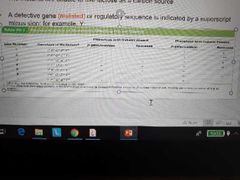
Enzymes are defective and cant use lactose as carbon source (lines 2 and 3) Y makes permease Z makes B-galactosidase **remember inducer allows synthesis to occur
|
|
|
|
What happens when the lac operator is mutated? |

Repressor cant bind to a defective operator so enzymes are produced all the time (constitutive expression) - line 4 |
|
|
|
What happens when the lac promotor is mutated? |
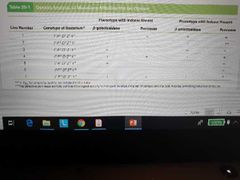
RNA polymerase wont bind as much so mrna production decreases even when inducer is present - line 5 |
|
|
|
What is catabolite repression? |
Used by bacteria to ensure glucose is metabolized preferentially when available (lac operon, CAP and cAMP) |
|
|
|
How does cAMP work in catabolite repression? |
Glucose inhibits adenyl cyclase, which makes cAMP. High glucose = low camp CAMP is the effector molecule that binds to allosteric regulator protein (catabolic activator protein) which turns on transcription Low glucose ->low adenyl cyclase->low camp High camp + catabolite activator protein -> transcription |
|
|
|
Describe CAP regulation of transcription |
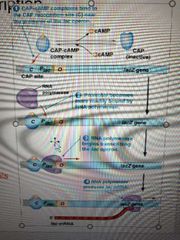
Camp binds to catabolic activator protein. This complex binds to CAP-binding site upstream of promotor Enhances rna polymerase binding to promoter, allowing transcription when glucose isnt present, to produce lactose |
|
|
|
What is dual control of gene expression? |
Transcription of a gene (ex: lac operon) can either be enhanced (by positive regulators like camp) or inhibited (by negative regulators like repressor proteins) |
|
|
|
Difference between inducible and repressible operons? |
Inducible - turned on by an allosteric effector (catabolic)
Repressible - turned off by end product allosteric effector (anabolic) |
|
|
|
How does the trp repressor work? |
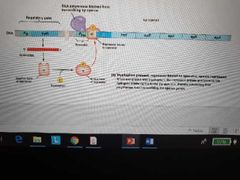
Regulatory gene (trpR) encodes repressor protein that must be activated by corepressor effector (trp) to stop transcription |
|
|
|
Describe parts of the tryptophan leader sequence |
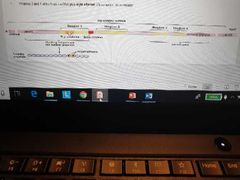
-located between promoter and trpE gene -14 amino acid long leader peptide is translated, which includes 2 trp codons -regions 1,2,3, and 4 that can bp in hairpin loops Regions 3,4, plus eight U's form terminator |
|
|
|
What happens in the leader sequence when tryptophan levels are low? |
A ribosome attaches to the first binding site on trp's mrna and follows the rna polymerase (tailgates) until it reaches the 2 trp codons, and then it waits for tRNAtrp aminoacyl, whose levels are also low.
During this time, region 1 is blocked, so regions 2 and 3 form antiterminator hairpin.
3 cannot form terminator loop with region 4, so rna polymerase continues to transcribe the trp operon |
|
|
|
What happens in the leader sequence if trp levels are high? |
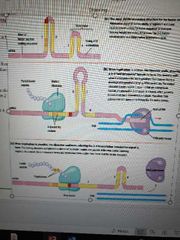
Trna trp aminoacyls are also high so ribosome is not stalled. It keeps going until it reaches region 2, blocking it. Regions 3 and 4 bp to form terminator loop and transcription stops |
|
|
|
List 5 levels of eukaryotic gene expression |
Genome, transcription and posttransciptional controls (rna processing and export, translation, posttranslational events) |
|
|
|
What is genomic equivalence? |
All cells have the same set of genes, but each cell expresses only a fraction of those genes |
|
|
|
First document of cloning? |
1958 - frederick steward grew carrots with the same nuclear dna as the original root cells |
|
|
|
What is nuclear transplantation/nuclear transfer? Examples? |
Transplantation - Cloning of an individual from which an original nucleus was taken
Ex: tadpole nuclei transplanted into eggs without nuclei. Some grew tadpoles
Transfer - nucleus of an egg is replaced with nucleus from adult cell
Ex: udder cells of white ewe were starved in culture to force them into dormant G0 stage.
Egg cell from black face ewe had nucleus removed and electrically shocked to fuse it to a starved udder cell
Fused egg cells implanted into other surrogate black faced sheep
White faced Dolly was born |
|
|
|
What causes defects in human/reproductive cloning attempts? |
Failure of dna in donated nuclei to undergo epigenetic programming Clones are either not generated or die prematurely |
|
|
|
Totipotent vs multipotent vs pluripotent? |
Totipotent - nuclei with a complete set of genes that can direct formation of a new organism
Multipotent - cells that can form several cells in a limited repertoire (stem cells from mature organisms)
Pluripotent- cells that can form all cell types that give rise to human organism except placenta and support membranes during gestation (embryonic stem cells) |
|
|
|
What is therapeutic cloning? What is its use? |
Production of stem cells genetically matched to a patient Used to replace damaged human cells |
|
|
|
Benefits of stem cells? |
They can replenish themselves They can form a variety of specialized cells in response to appropriate signals |
|
|
|
What do embryonic stem cells come from? |
Inner cell mass cells found at one end of an early embryo/blastocyst |
|
|
|
What is a proposed alternative to embryonic stem cells? |
Induced pluripotent stem cells -diffrentiated cells induced to a pluripotent state with many properties like those of ES cells. Discovered by shinya yamanaka |
|
|
|
What is the polyA tail? What is its function? |
50-250 adenines between an AAUAAA site and a GU or U rich site Added by polyA polymerase to protect mrna from nuclease, export the transcript into the cytoplasm, and help bind mrna to ribosome |
|
|
|
How were introns discovered? |
RNA and dna are hybridized into heteroduplexes, where rna displaces one of the dna strands and causes it to r-loop (sciencedirect.com/topics/biochemistry-genetics-and-molecular-biology/r-loop). However there were multiple r loops, which means there were sections of rna that couldn't base pair and were cleaved out (pg 550, textbook) |
|
|
|
How are splice sites determined? |

Consensus sequences found at intron-exon boundaries determine 5' and 3' splice sites. 5' has GU, 3' has AG with similar adjacent sequences at each end Branch point A near 3' also forms lariat loop when GU loops around (see youtube "rna splicing animation l spliceosome mediated splicing" by Biology animation videos) |
|
|
|
What are spliceosomes? |
Intron removal complex made of snRNP complexes, each with one or two snRNA molecules |
|
|
|
List steps for spliceosome assembly |
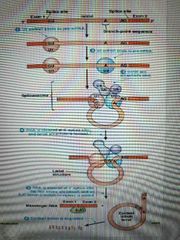
1. U1 snRNP binds to 5' GU splice site 2. U2 binds to branch point A 3. U4/U6 and U5 pull ends of intron together to make mature spliceosome 4. 5' splice site is cleaved and forms lariat with branch point A 5. 3' splice site is cleaved and exons are joined 6. Exon junction complex is placed where exons meet |
|

